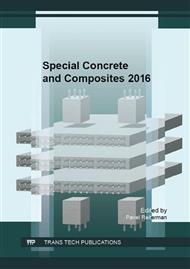[1]
CSN EN 197-1: Cement - Part 1: Composition, specifications and conformity criteria for common cements.
Google Scholar
[2]
K. Kolář, J. Litoš, Z. Bažantová, P. Reiterman, Measurement of Volume Changes of High Performance Cement Based Composites, Applied Mechanics and Materials, Vol. 827, pp.328-331, (2016).
DOI: 10.4028/www.scientific.net/amm.827.328
Google Scholar
[3]
Z. Bažantová, K. Kolář, P. Konvalinka, J. Litoš, P. Reiterman, New possibilities of rapid reconstructions of the concrete structures, Proceedings of Sanace 2016, VUT v Brně, 2016, 7 pages.
Google Scholar
[4]
CSN EN 196-1: Methods of testing cement - Part 1: Determination of strength.
Google Scholar
[5]
CSN 731322: Determination of frost resistance of concrete.
Google Scholar
[6]
K. Poloyhiy, J.A. Siddique, P. Reiterman, Low cost cement floor screed, Materials Science Forum 824 (2015) 77-80.
DOI: 10.4028/www.scientific.net/msf.824.77
Google Scholar
[7]
M. Hora, P. Reiterman, Assessment of the air-entraining effect of rubber powder and its influence on the frost resistence of concrete, Romanian Journal of Materials 46(3) (2016) 405-413.
Google Scholar
[8]
M. Kočová, J. Zatloukal, Relation between parameters of plasters measured by non-destructive and destructive methods, Key Engineering Materials 677 (2016) 211-214.
DOI: 10.4028/www.scientific.net/kem.677.211
Google Scholar
[9]
F. Vogel, O. Holčapek, M. Jogl, K. Kolář, P. Konvalinka, Development of Mechanical Properties of Steel Fibers Reinforced High Strength Concrete, Advanced Materials Research, Vol. 1077, pp.113-117, (2015).
DOI: 10.4028/www.scientific.net/amr.1077.113
Google Scholar
[10]
O. Holčapek, F. Vogel, P. Konvalinka, Analysis of mechanical properties of hydrothermally cured high strength matrix for textile reinforced concrete, Acta Polytechnica 55(5) (2015) 313-318.
DOI: 10.14311/ap.2015.55.0313
Google Scholar
[11]
M. Ženíšek, T. Vlach, L. Laiblová, Ground granulated blast furnace slag as partial replacement of the binder of high performance concrete, Advanced Materials Research 1054 (2014) 90-94.
DOI: 10.4028/www.scientific.net/amr.1054.90
Google Scholar
[12]
J. Brožovský, L. Bodnárová, R. Hela, R. Drochytka, V. Hela, Evaluation of degradation of concrete exposed to high temperature by means of ultrasonic pulse method, Applied Mechanics and Materials 284-287 (2013) 1315-1319.
DOI: 10.4028/www.scientific.net/amm.284-287.1315
Google Scholar
[13]
CSN EN 12504-4 (2005) Testing concrete-Part 4: Determination of ultrasonic pulse velocity. Czech standards institute, Prague.
Google Scholar
[14]
S.K.U. Rehman, Z. Ibrahim, S.A. Memon, M. Jameel, Nondestructive test methods for concrete bridges: A review, Construction and Building Materials 107 (2016) 58-86.
DOI: 10.1016/j.conbuildmat.2015.12.011
Google Scholar
[15]
B. Łaźniewska-Piekarczyk, The type of air-entraining and viscosity modifying admixtures and porosity and frost durability of high performance self-compacting concrete, Construction and Building Materials 40 (2013) 659-671.
DOI: 10.1016/j.conbuildmat.2012.11.032
Google Scholar
[16]
R. Alghamri, A. Kanellopoulos, A. Al-Tabbaa, Impregnation and encapsulation of lightweight aggregates for self-healing concrete, Construction and Building Materials 124 (2016) 910-921.
DOI: 10.1016/j.conbuildmat.2016.07.143
Google Scholar
[17]
M. Roig-Flores, F. Pirritano, P. Serna, L. Ferrara, Effect of crystalline admixtures on the self-healing capability of early-age concrete studied by means of permeability and crack closing tests, Construction and Building Materials 114 (2016).
DOI: 10.1016/j.conbuildmat.2016.03.196
Google Scholar
[18]
T. Hazelwood, A.D. Jefferson, R.J. Lark, D.R. Gardner, Numerical simulation of the long-term behaviour of a self-healing concrete beam vs standard reinforced concrete, Engineering Structures 102 (2015) 176-188.
DOI: 10.1016/j.engstruct.2015.07.056
Google Scholar


